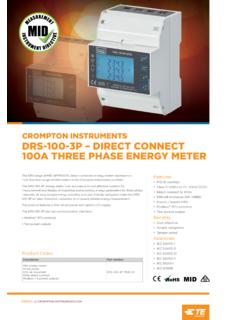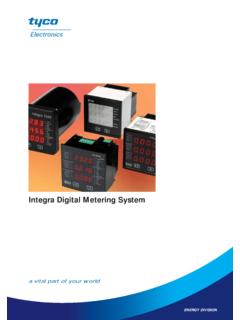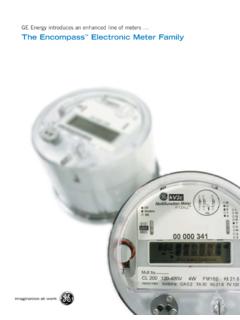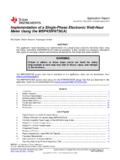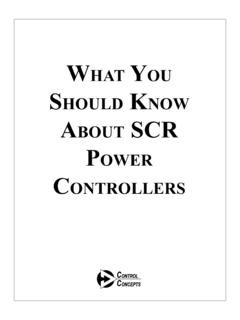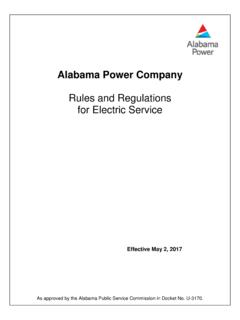Transcription of Installation and Operating Three-phase three wire …
1 Installation and Operating InstructionsThree-phase three wire Under and over voltage protector relays pvm -100/120, PVM-173/240, PVM-380/480 DIN-rail mounted Introduction These units monitor a 3-phase 3-wire supply and operate relays if a phase-phase voltage goes below or above set levels. Front panel controls allow selection of: Under- and over - voltage trip levels, nominal rated voltage , differential voltage for Operating hysteresis and time delay before a trip triggers a relay response. LEDs indicate power on and trip status. A relay with two changeover volt-free contacts is fitted. These instructions contain important safety information. Please read them thoroughly before commissioning, operation or maintenance of the unit. Specification Parameter PVM 100/120 173/240 380/480 Nominal voltage range (Un) 100-120V 173-240 380-480 Overload capacity - continuous 150V 300V 600V 10s max 180V 360V 720V Supply threshold (Uopen) 66V 114V 250V Operating frequency 45-65 Hz Burden on supply (Max) 3 over - voltage range (Umax) 100-125 %Un Under- voltage range (Umin) 75-100 %Un Differential Adjustable 1-15 %Un Trip time delay Adjustable to 10s Relay contacts.
2 2 x changeover, volt-free, for general switching operations Load capacity - 250V @ 8A, 2 kVA Load capacity - 30V 8A Insulation 4 kV/1 min Mechanical endurance 30x106 operations Other Data: Dimensions 90 x 105 x 64 mm Weight 123g approx. Maximum conductor size 2 x mm2 or 1 x mm2 Operating temperature -20 to +55 C Storage temperature -30 to +70 C over - voltage category III Pollution degree 2 Environmental protection IP40 for front panel IP20 for terminals. Standards EN 60255-6, EN 60255-27, EN 61000-2, EN 61000-4 Insulation Class: Ensure any external circuits connected to the relay are provided with double or reinforced insulation. The time delay and differential trip levels help to prevent relay chatter as the monitored voltage level varies.
3 As the relays have changeover contacts, the relay outputs can be inverted by wiring to the alternative terminals 15-16 or 25-26. Operation The unit obtains its power supply from the supply being monitored. The green LED lights to shows when this supply is present. Under normal conditions, with all three phases at nominal level, both red LEDs will be off, the Under relay will be energised and the over relay will be de-energised. With mains supply off, both relays will be de-energised. Under- voltage Mode If the monitored voltage of any phase goes below the set under- voltage level (Umin), the Under LED will light and the Under relay (15-16/18) will de-energise after the set delay. During the delay period, the Under LED will flash. If the voltage then returns above Umin plus the differential value, the Under LED will go off and the Under relay will energise again, without delay. If one (or two) phase voltage (s) falls below the Operating threshold (Uopen), both relays will de-energise and both red LEDs will flash slowly to indicate the supply deficiency.
4 over - voltage Mode If the monitored voltage of any phase goes above the set over - voltage level (Umax), the over LED will light and the over relay (25-26/28) will energise after the set delay. During the delay period, the over LED will flash. If the voltage then falls below Umax minus the differential value, the over relay will de-energise and the over LED will go off, without delay. Note; Red LED indicates fault condition, not relay status Ref: PVM APR11-REV1 Page 1 of 2 Page 2 of 2 Installation The unit is intended for mounting on a standard DIN rail. Hook the unit onto the top of the rail and press the bottom of the unit until it locks in place. To remove the unit from the rail, lever down the black tab at the bottom of the unit to release it from the rail. The unit is intended for use in a reasonably stable ambient temperature within the range -20 to +55 C. Do not mount the unit where there is excessive vibration or in excessive direct sunlight.
5 All of the above information, including drawings, illustrations and graphic designs, reflects our present understanding and is to the best of our knowledge and belief correct and reliable. Users, however, should independently evaluate the suitability of each product for the desired application. Under no circumstances does this constitute an assurance of any particular quality or performance. Such an assurance is only provided in the context of our product specifications or explicit contractual arrangements. Our liability for these products is set forth in our standard terms and conditions of sale. TE connectivity (logo), TE (logo) and TE Connectivity are trademarks of the TE Connectivity Ltd. family of companies. CROMPTON is a trademark of Crompton Parkinson Ltd. and is used by TE Connectivity Ltd. under licence. Other logos, product and company names mentioned herein may be trademarks of their respective owners.
6 Tyco Electronics UK Ltd. a TE Connectivity Ltd. company Freebournes Road, Witham, CM8 3AH Tel: +44 (0) 1376 509509, Fax: +44 (0) 1376 509511 NC = Normally closed. Contact closed when relay de-energised. NO = Normally open. Contact open when relay de-energised. Warnings: During normal operation, voltages hazardous to life may be present at some of the terminals of this unit. Installation and servicing should be performed only by qualified, properly trained personnel abiding by local regulations. Ensure all supplies are de-energised before attempting connection or other procedures. It is recommended adjustments be made with the supplies de-energised, but if this is not possible, then extreme caution should be exercised. Terminals should not be user accessible after Installation and external Installation provisions must be sufficient to prevent hazards under fault conditions.
7 This unit is not intended to function as part of a system providing the sole means of fault protection - good engineering practice dictates that any critical function be protected by at least two independent and diverse means. The unit does not have internal fuses therefore external fuses must be used for protection and safety under fault conditions. If this equipment is used in a manner not specified by the manufacturer, protection provided by the equipment may be impaired. Safety The unit was designed in accordance with BS EN 600255-6 and -27 Permanently connected use, Normal condition. Insulation category III, pollution degree 2, basic insulation for rated voltage . Measurement Category III. EMC Installation Requirements This unit has been designed to provide protection against EM (electro-magnetic) interference in line, in accordance with BS EN 61000-6-2 and -6-4.
8 Precautions necessary to provide proper operation of this and adjacent equipment will be Installation dependent and so the following can only be general guidance: Avoid routing wiring to this unit alongside cables and products that are, or could be, a source of interference. To protect the product against incorrect operation or permanent damage, surge transients must be controlled. It is good EMC practice to suppress differential surges to 2kV or less at the source. The unit has been designed to automatically recover from typical transients, however in extreme circumstances it may be necessary to temporarily disconnect the auxiliary supply for a period of greater than 5 seconds to restore correct operation. Screened communication leads are recommended and may be required. These and other connecting leads may require the fitting of RF suppression components, such as ferrite absorbers, line filters etc.
9 , if RF fields cause problems. It is good practice to install sensitive electronic instruments that are performing critical functions in EMC enclosures that protect against electrical interference causing a disturbance in function. Wiring All connections are made to screw clamp terminals. Terminals are suitable for copper wires only and will accept one stranded - (30 - 12 AWG) stranded or one solid core cable. Terminal screws should be tightened to Nm. Choice of cable should meet local regulations. Instrument transformers used for connection to the meter must be of approved type, compliant with ANSI/IEEE / IEC 60044-1 to provide isolation from measuring inputs. For UL approved Installation , use National Electrical Code (NEC) Class 1 wiring, rated at 600V for main terminals, 300V auxiliary / 60 C min rating. Caution: Risk of Electric Shock Fusing A suitable switch or circuit breaker conforming to the relevant parts of IEC 60947-1 and IEC 60947-3 should be included in the building Installation .
10 It should be positioned so as to be easy to operate, in close proximity to the equipment, and clearly identified as the disconnecting device. This unit must be fitted with external fuses in voltage supply lines. Lines must be fused with a quick blow fuse 1A maximum. Choose fuses of a type and with a breaking capacity appropriate to the supply and in accordance with local regulations. For UL approved installations: UL listed branch circuit fuses, suitable for the Installation voltage , shall be provided and installed in accordance with national Installation code 1A fast acting AC rated at the inputs. Maintenance In normal use, little or no maintenance is needed. Where used, ensure any CT secondary circuits are short circuited prior to carrying out Installation or maintenance of the unit. As appropriate for service conditions, isolate electrical power, inspect the unit and remove any dust or other foreign material present.
